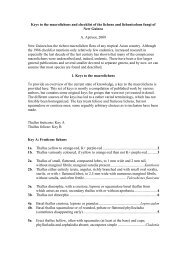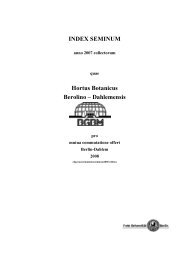DIG35 Specification: Metadata for Digital Images. Version 1.0
DIG35 Specification: Metadata for Digital Images. Version 1.0
DIG35 Specification: Metadata for Digital Images. Version 1.0
Create successful ePaper yourself
Turn your PDF publications into a flip-book with our unique Google optimized e-Paper software.
Chapter 1:Introduction <strong>DIG35</strong> <strong>Specification</strong> 2000-08-30Chapter 1: Introduction<strong>Metadata</strong> is additional in<strong>for</strong>mation that is associated with the primary data. In the context of this specification, it is “additionaldata linked with the image data beyond the pixels which define the image.” <strong>Metadata</strong>, to be most valuable <strong>for</strong> the owner(s) anduser(s) of an image, needs to be consistently maintained throughout the image lifecycle. In today's environment of imageediting applications, rapid transmission via the Internet, and high quality photographic digital cameras and printers, thelifecycle of a digital image may be very long as well as complex.However, if standards <strong>for</strong> managing and exchanging the metadata <strong>for</strong> these images, including associated data input methods <strong>for</strong>users, do not materialize, we will be left with the digital equivalent of the "shoebox" and will not realize the full potential ofdigital imaging power and flexibility.Realizing this the <strong>Digital</strong> Imaging Group <strong>for</strong>med an Initiative Group in early 1999 to begin addressing the issues involved andprovide the first step towards a standard set of metadata <strong>for</strong> digital images. This Initiative Group (commonly called <strong>DIG35</strong>)includes representatives from Adobe Systems Inc., AGFA-GEVAERT N.V., Canon Inc., Eastman Kodak Company, FujiPhoto Film Co., Ltd., Hewlett Packard Company, Microsoft Corporation, NETIMAGE, PhotoChannel Networks Inc.,PhotoWorks, Inc., PictureIQ Corporation, Polaroid Corporation, and WorkStation.com.The result of this broad collaboration of imaging and technology industry participants is this technical specification definingspecific metadata <strong>for</strong> digital images and a recommended implementation model. In total this set of documents comprises the"<strong>DIG35</strong> <strong>Metadata</strong> <strong>Specification</strong> <strong>for</strong> <strong>Digital</strong> Image <strong>Metadata</strong>" or <strong>DIG35</strong> <strong>Specification</strong> (often referred to simply as "<strong>DIG35</strong>").1.1 Vision and GoalsThe vision of the <strong>DIG35</strong> is:“To provide a mechanism to allow end-users to see digital image use as being equally as easy, as convenient, and as flexibleas the traditional photographic methods while allowing benefits that are possible only with a digital <strong>for</strong>mat.”The overall goal of the <strong>DIG35</strong> initiative is to define a standard set of metadata <strong>for</strong> digital images that will improve the semanticinteroperability between devices, services and software. This interoperability will make it easier to organize, print, exchangeand otherwise process digital images in this new millennium.1.2 ScopeThis specification defines a set of public metadata <strong>for</strong> digital still images. These images may encompass a single image or acollection of images that could be supported and exchanged by current and future devices, software, and services in an openenvironment. In addition to the metadata definition, a recommendation <strong>for</strong> implementation is defined to enable exchange ofsuch metadata.This specification does not concern itself with vendor-specific proprietary private metadata or a particular application domain.Private or application domain-specific metadata should be defined within their respective organizations and, as such is out ofthe scope of this specification.Additionally, the <strong>DIG35</strong> <strong>Specification</strong> does not mandate procedural metadata i such as processing parameters which changesthe visual appearance after decoding the image data (e.g. cropping, rotating etc.), printing in<strong>for</strong>mation (e.g. number of copies,output size etc.) and ordering in<strong>for</strong>mation (e.g. delivery and payment in<strong>for</strong>mation). There are, however, exceptions at this time.Print Aspect Ratio (PAR) metadata is an example that does not follow this rule. Technical metadata that are well-defined andintended to produce better quality images that benefit the users without additional user ef<strong>for</strong>t are considered exceptions.i Such metadata are either discussed in other organizations or subject to future discussions and ef<strong>for</strong>ts by the <strong>Digital</strong> Imaging Group.<strong>Version</strong> <strong>1.0</strong> © 2000 <strong>Digital</strong> Imaging Group, Inc. 1




